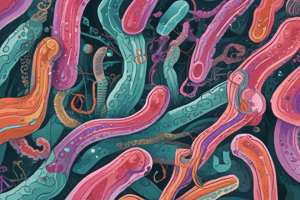Podcast
Questions and Answers
Which virulence factor primarily helps bacteria resist phagocytosis?
Which virulence factor primarily helps bacteria resist phagocytosis?
- Fimbriae
- Bacterial toxins
- Teichoic acid
- Capsule (correct)
What is the role of collagenase in bacterial virulence?
What is the role of collagenase in bacterial virulence?
- Enhances microbial invasion by degrading collagen (correct)
- Degrades red blood cells
- Interferes with immune response
- Neutralizes acidic pH
Which of the following statements about bacterial exotoxins is true?
Which of the following statements about bacterial exotoxins is true?
- They can be detoxified to form toxoids for vaccination. (correct)
- They are heat stable.
- They are produced only by Gram-negative bacteria.
- They are part of the bacterial cell wall.
Which enzyme produced by some microbes can hydrolyze the beta-lactam ring of antibiotics?
Which enzyme produced by some microbes can hydrolyze the beta-lactam ring of antibiotics?
What makes bacterial endotoxins less antigenic than exotoxins?
What makes bacterial endotoxins less antigenic than exotoxins?
Which pigment is associated with the bacterium Pseudomonas aeruginosa?
Which pigment is associated with the bacterium Pseudomonas aeruginosa?
What is the primary function of fimbriae in bacterial pathogenicity?
What is the primary function of fimbriae in bacterial pathogenicity?
Which enzyme helps bacteria neutralize acidic conditions in urine and stomach?
Which enzyme helps bacteria neutralize acidic conditions in urine and stomach?
What characteristic distinguishes exotoxins from endotoxins?
What characteristic distinguishes exotoxins from endotoxins?
Which of the following bacterial enzymes assists in the coagulation of plasma?
Which of the following bacterial enzymes assists in the coagulation of plasma?
Flashcards
What is Fimbriae?
What is Fimbriae?
A structure on the surface of a bacteria that helps it cling to host cells, making it more likely to infect.
What is a capsule?
What is a capsule?
A thick, protective layer on the outside of some bacteria that helps them evade the immune system. It shields bacteria from phagocytosis and lysosomes.
What is Teichoic Acid?
What is Teichoic Acid?
A type of molecule found in the cell walls of Gram-positive bacteria that promotes adhesion to host cells.
What are Collagenases?
What are Collagenases?
Signup and view all the flashcards
What are Hemolysins?
What are Hemolysins?
Signup and view all the flashcards
What are Exotoxins?
What are Exotoxins?
Signup and view all the flashcards
What are Endotoxins?
What are Endotoxins?
Signup and view all the flashcards
What are Bacterial Pigments?
What are Bacterial Pigments?
Signup and view all the flashcards
What are exopigments?
What are exopigments?
Signup and view all the flashcards
What are endopigments?
What are endopigments?
Signup and view all the flashcards
Study Notes
Bacterial Growth (2) - Bacterial Genetics and Virulence Factors
- Bacterial virulence factors are cellular structures, enzymes, and toxins that enhance bacterial pathogenicity.
- Key virulence factors include the capsule, fimbriae (pili), teichoic acid, enzymes, bacterial toxins (exotoxins/endotoxins), and pigments.
1- Bacterial Virulence
- Capsule: Resist phagocytosis and hydrolytic enzymes (lysozymes) that break down cell walls. Adheres to host cells.
- Fimbriae (Pili): Adheres to host cell surfaces.
- Teichoic Acid (Gram-positive bacteria): Adheres to host cell surfaces.
4- Microbial Enzymes
- Collagenase: Aids microbial invasion by degrading the extracellular matrix (collagen).
- Urease: Neutralizes acidic pH in urine and stomach.
- Hemolysin: Degrades red blood cells (RBCs) and releases hemoglobin.
- Haemagglutinin and coagulase enzyme: Agglutinates RBCs and coagulates plasma; the microbe can escape humoral immunity.
- Catalase: Breaks down hydrogen peroxide (H₂O₂) into water (H₂O) and oxygen (O₂).
5- Bacterial Toxins
- Exotoxins: Produced by Gram-positive and Gram-negative bacteria, diffuse outside the bacteria, are proteins, heat-labile, and toxoids formed for vaccine use.
- Endotoxins: Produced by Gram-negative bacteria, part of the cell wall, are lipopolysaccharides, heat-stable, have no effect from formalin treatment, and are less antigenic.
- Examples: Clostridium botulinum toxin and Clostridium tetani toxin.
6- Bacterial Pigments
- Exopigments: Diffuse into the surrounding medium, an example is bluish-green pigments from Pseudomonas aeruginosa.
- Endopigments: Stay within the cell.
2- Bacterial Genetics
- Bacterial Chromosome: A single circular, double-stranded DNA.
- Plasmids: Additional genetic material outside the chromosome; circular, supercoiled DNA carrying important genes like those for resistance.
Mechanisms of Gene Transfer
- Conjugation: Transfer of plasmids from one bacterial cell to another via sex pili (in gram-negative bacteria).
- Transduction: Transfer of genetic material through a virus (bacteriophage).
- Transformation: Uptake of DNA fragments from a lysed donor bacterial cell by a recipient cell.
Additional Information
- Corynebacterium diphtheriae: This bacterium causes diphtheria and produces diphtheria toxin. The gene encoding the toxin is transferred to other bacteria via a bacteriophage (transduction).
Studying That Suits You
Use AI to generate personalized quizzes and flashcards to suit your learning preferences.




